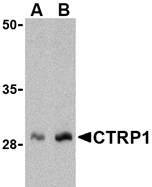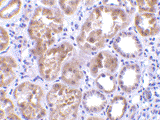Catalog#:3557
Adipose tissue of an organism plays a major role in regulating physiologic and pathologic processes such as metabolism and immunity by producing and secreting a variety of bioactive molecules termed adipokines (reviewed in 1). One highly conserved family of adipokines is adiponectin/ACRP30 and its structural and functional paralogs, the C1q/tumor necrosis factor-?-related proteins (CTRPs) 1-7 (2). Unlike adiponectin, which is expressed exclusively by differentiated adipocytes, the CTRPs are expressed in a wide variety of tissues (3). These proteins are thought to act mainly on liver and muscle tissue to control glucose and lipid metabolism. An analysis of the crystal structure of adiponectin revealed a structural and evolutionary link between TNF and C1q-containing proteins, suggesting that these proteins arose from a common ancestral innate immunity gene (4). In obese (ob/ob) mice, RT-PCR analysis showed that mCTRP1 transcripts are seen at substantially higher levels in adipose tissues compared to those of normal mice (3).
Additional Names: CTRP1 (NT), G protein coupled receptor interacting protein 1 / GIP

Description
Left: Western blot analysis of CTRP1 in human kidney cell lysate with CTRP1 antibody at (A) 1 and (B) 2 µg/ml.
Below: Immunohistochemistry of CTRP1 in human kidney tissue with CTRP1 antibody at 10 µg/ml.
Other Product Images
 Source:CTRP1 (NT) antibody was raised against a 15 amino acid peptide from near the amino-terminus of human CTRP1.
Source:CTRP1 (NT) antibody was raised against a 15 amino acid peptide from near the amino-terminus of human CTRP1.
Purification: Affinity chromatography purified via peptide column
Clonality and Clone: This is a polyclonal antibody.
Host: CTRP1 antibody was raised in rabbit.
Please use anti-rabbit secondary antibodies.
Immunogen: Human CTRP1 / G protein coupled receptor interacting protein 1 / GIP (N-Terminus) Peptide (Cat. No.
Application: CTRP1 antibody can be used for the detection of CTRP1 by Western blot at 1 µg/ml.These proteins are often highly modified post-translationally and migrate in SDS-PAGE at positions other than their predicted size.
Tested Application(s): E, WB, IHC
Buffer: Antibody is supplied in PBS containing 0.02% sodium azide.
Blocking Peptide:Cat. No. 3557P - CTRP1 Peptide
Long-Term Storage: CTRP1 antibody can be stored at 4ºC, stable for one year. As with all antibodies care should be taken to avoid repeated freeze thaw cycles. Antibodies should not be exposed to prolonged high temperatures.
Positive Control:
1. Cat. No. 1305 - Human Kidney Tissue Lysate
Species Reactivity: H, M, R
GI Number: 38372917
Accession Number: NP_940995
Short Description: (NT) a novel adipokine
References
1. Fantuzzi G. Adipose tissue, adipokines, and inflammation. J. Allergy Clin. Immunol. 2005; 115:911-9.
2. Tsao T-S, Lodish HF, and Fruebis J. ACRP30, a new hormone controlling fat and glucose metabolism. Euro. J. Pharmacol. 2002; 440:213-21.
3. Wong GW, Wang J, Hug C, et al. A family of Acrp30/ adiponectin structural and functional paralogs. Proc. Natl. Acad. Sci. USA 2004; 101:10302-7.
4. Shapiro L and Scherer PE. The crystal structure of a complement-1q family protein suggests an evolutionary link to tumor necrosis factor. Curr. Biol. 1998; 8:335-8

Description
Left: Western blot analysis of CTRP1 in human kidney cell lysate with CTRP1 antibody at (A) 1 and (B) 2 µg/ml.
Below: Immunohistochemistry of CTRP1 in human kidney tissue with CTRP1 antibody at 10 µg/ml.
Other Product Images
 Source:CTRP1 (NT) antibody was raised against a 15 amino acid peptide from near the amino-terminus of human CTRP1.
Source:CTRP1 (NT) antibody was raised against a 15 amino acid peptide from near the amino-terminus of human CTRP1.Purification: Affinity chromatography purified via peptide column
Clonality and Clone: This is a polyclonal antibody.
Host: CTRP1 antibody was raised in rabbit.
Please use anti-rabbit secondary antibodies.
Immunogen: Human CTRP1 / G protein coupled receptor interacting protein 1 / GIP (N-Terminus) Peptide (Cat. No.
Application: CTRP1 antibody can be used for the detection of CTRP1 by Western blot at 1 µg/ml.These proteins are often highly modified post-translationally and migrate in SDS-PAGE at positions other than their predicted size.
Tested Application(s): E, WB, IHC
Buffer: Antibody is supplied in PBS containing 0.02% sodium azide.
Blocking Peptide:Cat. No. 3557P - CTRP1 Peptide
Long-Term Storage: CTRP1 antibody can be stored at 4ºC, stable for one year. As with all antibodies care should be taken to avoid repeated freeze thaw cycles. Antibodies should not be exposed to prolonged high temperatures.
Positive Control:
1. Cat. No. 1305 - Human Kidney Tissue Lysate
Species Reactivity: H, M, R
GI Number: 38372917
Accession Number: NP_940995
Short Description: (NT) a novel adipokine
References
1. Fantuzzi G. Adipose tissue, adipokines, and inflammation. J. Allergy Clin. Immunol. 2005; 115:911-9.
2. Tsao T-S, Lodish HF, and Fruebis J. ACRP30, a new hormone controlling fat and glucose metabolism. Euro. J. Pharmacol. 2002; 440:213-21.
3. Wong GW, Wang J, Hug C, et al. A family of Acrp30/ adiponectin structural and functional paralogs. Proc. Natl. Acad. Sci. USA 2004; 101:10302-7.
4. Shapiro L and Scherer PE. The crystal structure of a complement-1q family protein suggests an evolutionary link to tumor necrosis factor. Curr. Biol. 1998; 8:335-8

No comments:
Post a Comment